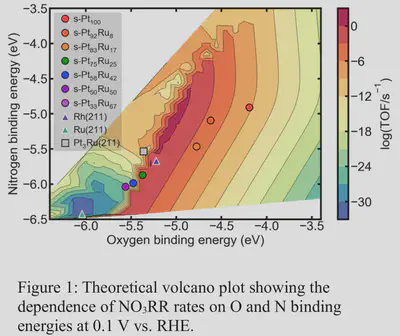AIChE 2021: Platinum-Ruthenium Alloys As Electrocatalysts for Efficient Aqueous Nitrate Reduction

Abstract
Aqueous nitrate constitutes one of the most prevalent wastewater pollutants and deeply imbalance the global nitrogen cycle. Electrocatalytic nitrate reduction (NO3RR), which can be powered by renewable electricity, can sustainably remediate nitrate while generating useful products such as NH3 or N2. However, we have yet to identify many sufficiently active, selective, and economically feasible electrocatalysts. Here we report density functional theory predictions of intrinsic nitrate reduction rates on PtRu alloy models (PtxRuy, x = 50–100%). We employed a random surface alloying technique to simulate ensembles of Ru atoms at the surface. We demonstrate linear scaling relationships and perform mean-field microkinetic modeling to predict relative NO3RR turnover frequencies as a function of O and N binding energies and applied potential. Figure 1 shows that O and N binding strengths (which correlates with nitrate binding strength) increase with increasing Ru composition and that nitrate reduction activity reaches a maximum at 25 at% Ru surface composition. The calculations are consistent with experimental activity measurements of nitrate reduction on synthesized platinum-ruthenium catalysts (PtxRuy/C, x = 48–100%). These experiments show that PtxRuy/C alloys are more active than Pt/C, with Pt78Ru22/C six times more active than Pt/C at 0.1 V vs. RHE. This maximum in activity arises from a transition from nitrate dissociation as the rate-determining step to a new rate-determining step at higher Ru composition. These results demonstrate that the same descriptors used in our previous nitrate reduction study on pure metals can also be used to analyze alloys.
Our work demonstrates that NO3RR electrocatalyst performance is tunable by changing the adsorption strength of reacting species through alloying. It also provides a path to conduct alloy catalyst screening via theoretical volcano plots for pure metals. Ultimately, our results will help simplify the search for active, selective, and cheap electrocatalysts for many reactions.
